Kitsune Udon is a Japanese noodle soup in dashi broth, topped with seasoned fried tofu, pink-swirl narutomaki fish cake, and scallions. This hearty udon soup is one of the most popular, classic Japanese noodle dishes.
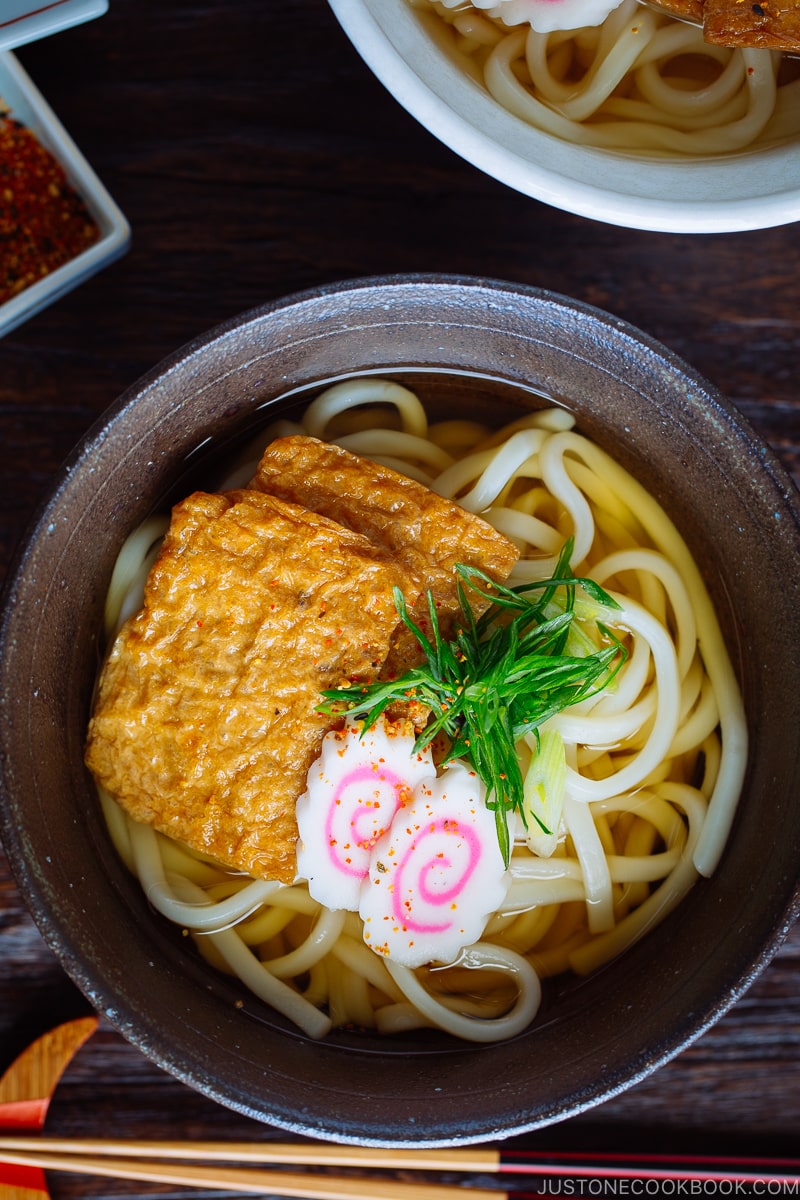
If you’re looking for the ultimate Japanese comfort dish that can lift up your mood any time of year, I can’t recommend enough cooking this bowl of Kitsune Udon (Noodle Soup) (きつねうどん).
The rich broth, the chewy noodles, and the fried tofu – everything comes together so nicely that you just want to hold your face above the bowl and let the aroma envelop you. It’s so simple and quick to make, so there is no excuse not to try it!
What is Kitsune Udon?
Kitsune literary means ‘fox’ in Japanese. Why do we call the dish ‘fox udon’? There are a few theories about the origin of the name.
One theory says aburaage (deep-fried tofu pouch) often appears as a fox’s favorite food in Japanese folktales, so people started to call the udon noodle soup topped with tofu pouch as “kitsune udon.”
Another theory is that people call aburaage by “kitsune” because the color of the deep-fried tofu pouch is like the color of a fox. I think this makes the most sense since we often say in Japanese recipes “cook till fox color” to figuratively describe “cook till golden brown”.
So what is kitsune udon? It’s made of chewy thick udon noodles, clear dashi broth, and aburaage seasoned well with soy sauce, mirin, and sugar. Kitsune udon is served as a hot noodle soup, but in the steamy summer months, it is also served chilled with a few spoonfuls of dashi based sauce poured over.
3 Key Ingredients for Kitsune Udon
To make the perfect bowl of kitsune udon, you need high-quality ingredients, starting with these three: dashi, udon noodles, and aburaage.
1. Dashi Broth
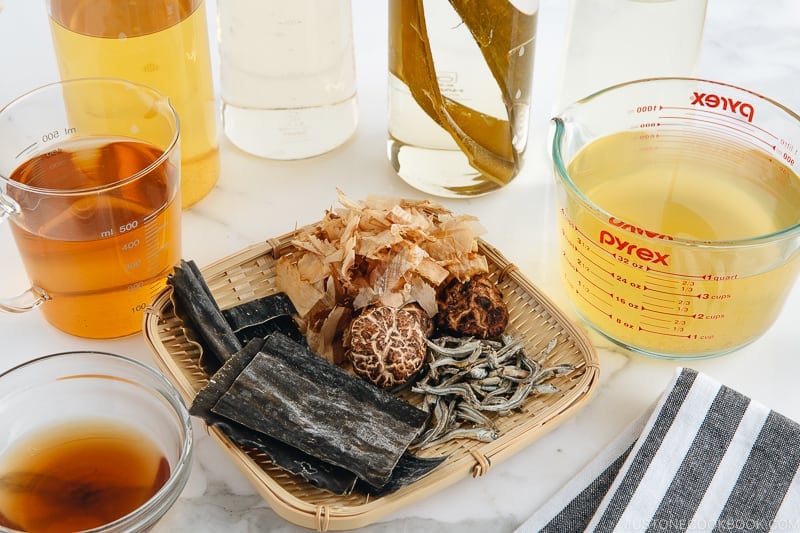
I can’t stress enough about having good quality dashi. The dashi broth gives the noodle soup that rich, umami flavor that will have you sipping up the last drops.
Dashi is so important, which is why I have previously shared three ways to make dashi – using dashi powder or a dashi packet and making dashi from scratch.
For this kitsune udon recipe, I only recommend making dashi using a dashi packet or making it from scratch. Making it with dashi powder doesn’t have the depth needed to make a flavorful enough broth. Please don’t get intimidated with making dashi from scratch. It really doesn’t take a lot of time compared to using dashi powder. Spend the extra 20 minutes to make a super tasty broth – trust me, it’s worth your time, and it’s easy to make!
I recommend making Awase Dashi (kombu + katsuobushi/bonito flakes) or Katsuo Dashi (just bonito flakes) for udon noodle soup broth.
For vegetarian/vegan dashi, use Kombu Dashi.
2. Udon Noodles
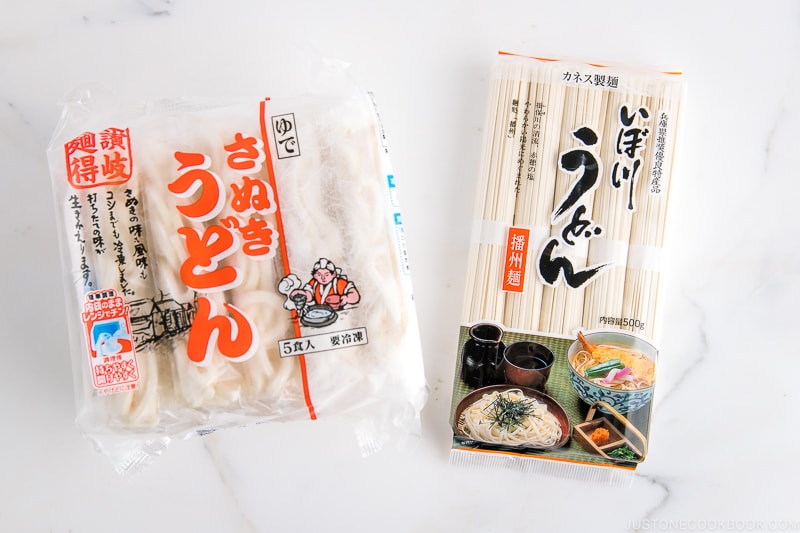
Udon noodles are getting very popular outside of Japan, so you can easily purchase the noodles in regular grocery stores in the U.S. However, many products are not very good. The noodles don’t have the right texture and tend to break into pieces.
If your local Japanese or Asian grocery stores carry frozen udon noodles or packaged udon noodles that say “Sanuki”, try one of those options. They are chewier and not doughy/floury, and won’t break easily.
3. Packaged vs. Homemade Aburaage

Living outside of Japan, I know that raw ingredients can be harder to find than prepackaged foods.
Inari age (seasoned deep-fried tofu pouch) is made of aburaage (deep-fried tofu pouch). When you want to make homemade Inari age, you need aburaage, but it’s really difficult to find unless you have a well-stocked Japanese grocery store.
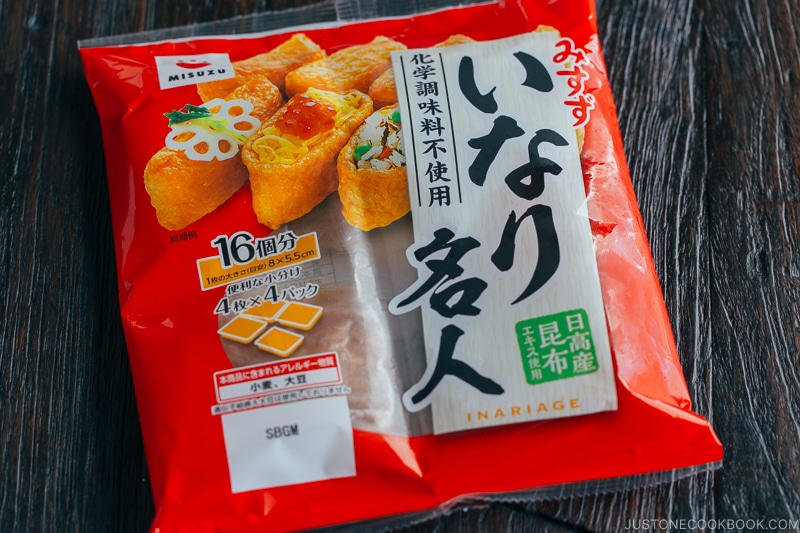
Packaged Inari age is widely-available even in Asian grocery stores as they are used for making the popular Inari Sushi.
If you are the lucky one who can find aburaage, try making my Homemade Inari Age! It’s preservative-free and really delicious!
Vegetarian/Vegan-Friendly Kitsune Udon
There is a misconception that dashi is not vegetarian/vegan; however, that’s not completely true. Most well-known dashi is made with bonito flakes and kombu, but in our daily Japanese cooking, we also use Kombu Dashi, which is 100% vegetarian/vegan.
To make vegetarian/vegan kitsune udon, make kombu dashi and skip those spiral fish cakes as a garnish. And as simple as that, you have vegetarian/vegan kitsune udon!
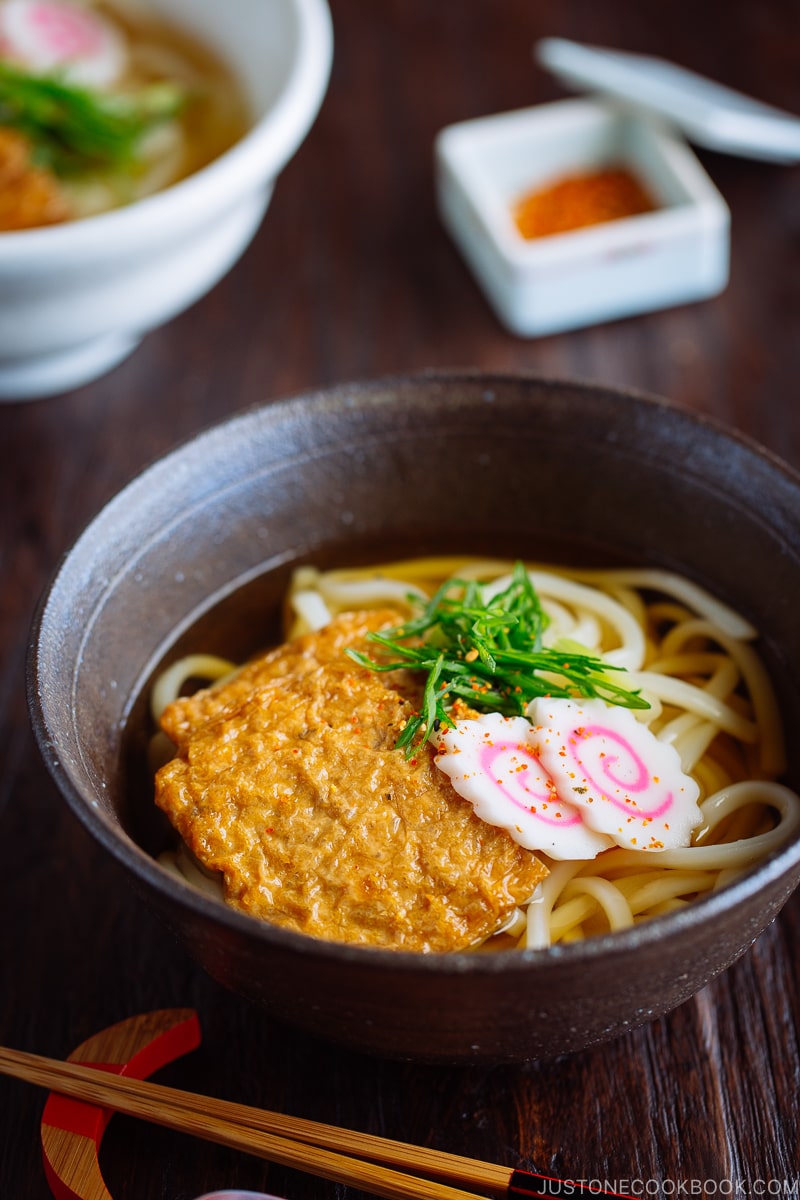
Did You Watch Netflix “Midnight Diner: Tokyo Stories” Season 2?
You can find this Kitsune Udon dish featured on the popular Netflix® – Midnight Diner: Tokyo Stories (Season 2, Episode 7).

In the show, the master prepares a bowl of Kitsune Udon with a large homemade Inari age. It’s such a humble dish, yet so comforting and satisfying.
Other Hot Udon Noodle Soup Recipes
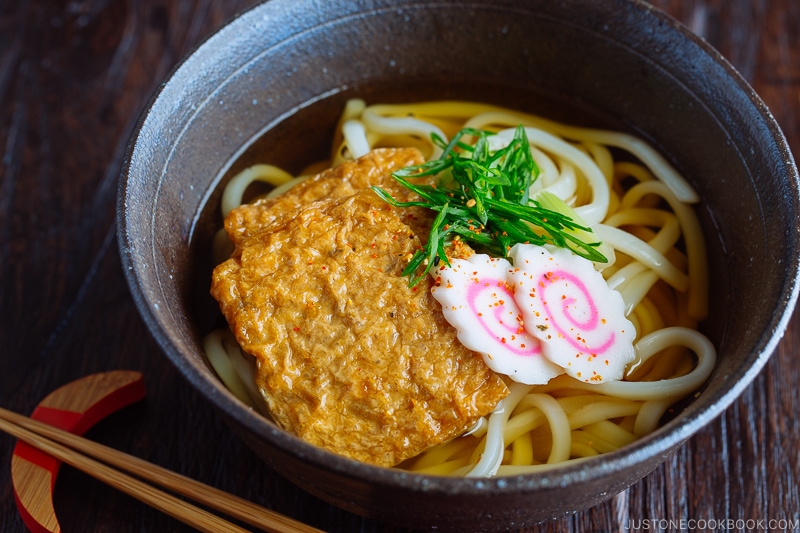
Wish to learn more about Japanese cooking? Sign up for our free newsletter to receive cooking tips & recipe updates! And stay in touch with me on Facebook, Pinterest, YouTube, and Instagram.

Kitsune Udon
Video
Ingredients
For the Homemade Dashi
- 1 piece kombu (dried kelp) (2 x 5 inches, 5 x 12 cm per piece)
- 2½ cups water
- 1½ cups katsuobushi (dried bonito flakes) (packed; ½ oz; skip for vegetarian/vegan)
For the Soup Broth
- 2½ cups dashi (Japanese soup stock) (use standard Awase Dashi, dashi packet or powder, or Vegan Dashi); dashi recipe instructions included below)
- 1 Tbsp mirin
- 1 tsp sugar
- 1 Tbsp usukuchi (light-colored) soy sauce (can substitute regular soy sauce)
- ½ tsp Diamond Crystal kosher salt
For the Kitsune Udon
- 4 Inari age (seasoned fried tofu pouch) (canned or refrigerated; or make my homemade Inari Age)
- 1 green onion/scallion
- 4 slices narutomaki (fish cakes) (optional; skip for vegetarian/vegan)
- 2 servings udon noodles (1.1 lb, 500 g frozen or parboiled udon noodles; 6.3 oz, 180 g dry udon noodles)
- shichimi togarashi (Japanese seven spice) (optional; or a spicy kick)
Instructions
Before You Start…
- Gather all the ingredients. It‘s really important to have good flavorful dashi for this recipe. Although you can take a shortcut by using dashi powder or a dashi packet, I encourage you to make dashi from scratch because the broth tastes so much better! It only takes less than 30 minutes to make. See my instructions below for Awase Dashi and Kombu Dashi (vegetarian/vegan).

To Make the Homemade Dashi
- Put 1 piece kombu (dried kelp) and 2½ cups water in a measuring cup for at least 30 minutes. If you have time, soak for 3 hours or up to half a day. The kombu’s flavor comes out naturally from soaking it in water. If you don’t have time, skip soaking.

- Transfer the kombu and water to a saucepan. Slowly bring to a boil over medium-low heat.

- Just before the liquid boils (you will see bubbles around the edges of the pan), remove the kombu. If you leave the kombu inside, the dashi will become slimy and bitter. Now, this broth is vegetarian/vegan Kombu Dashi and it‘s ready to use. For non-vegetarian/vegan, add 1½ cups katsuobushi (dried bonito flakes) and bring it to a boil again.

- Once the dashi is boiling, reduce the heat, simmer for just 15 seconds, and turn off the heat. Let the katsuobushi sink to the bottom, about 10–15 minutes. Strain the dashi through a fine-mesh sieve set over a saucepan. Now you have homemade Awase Dashi.

To Make the Soup Broth
- In a saucepan, add 2½ cups dashi (Japanese soup stock), 1 Tbsp mirin, 1 tsp sugar, 1 Tbsp usukuchi (light-colored) soy sauce, and ½ tsp Diamond Crystal kosher salt and bring it to a boil. Once boiling, turn off the heat or cover and keep on a low simmer. Tip: We use the light-colored usukichi type of soy sauce here so the color of the soup broth doesn‘t become too dark.

To Prepare the Toppings
- Squeeze the excess liquid from 4 Inari age (seasoned fried tofu pouch) (or you can keep the liquid as is, if you prefer). Cut 1 green onion/scallion into thin slices. Cut 4 slices narutomaki (fish cakes) into ⅛-inch (3-mm) slices.

To Cook the Udon Noodles
- Bring a large pot of water to a boil for 2 servings udon noodles. My favorite udon is frozen Sanuki udon. Reheat the frozen udon noodles in boiling water for 1 minute (no need to defrost). If you use dry noodles, follow the package instructions.

- Pick up the noodles in a strainer or drain the hot water. Make sure to shake off the excess water (which will end up diluting your soup).

To Serve
- Divide the drained udon noodles into individual serving bowls. Pour the hot broth over the noodles to cover. Top with the Inari age, narutomaki, and green onions. Sprinkle shichimi togarashi (Japanese seven spice) on top (optional).

To Store
Nutrition
Editor’s Note: The post was originally published on May 25, 2011. Pictures were updated in November 2017. The new video was added in April 2018. The post has been updated in May 2020.
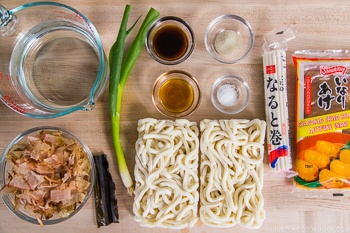
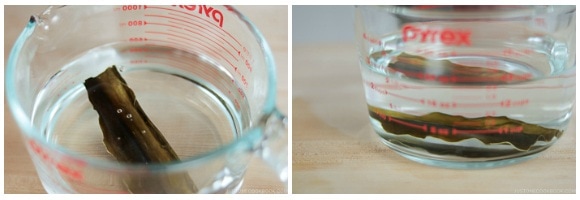
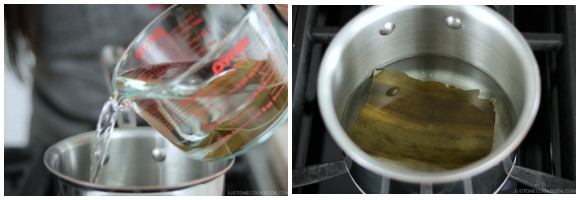
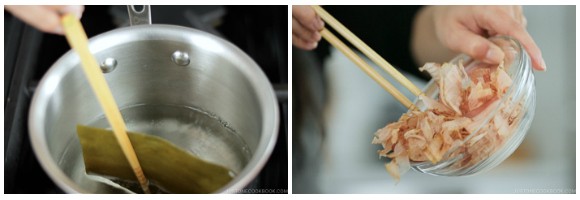
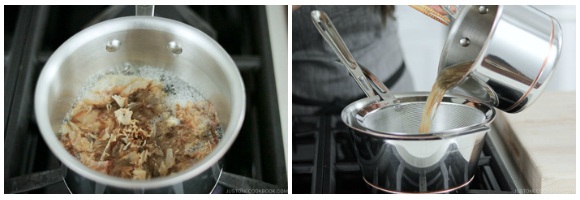
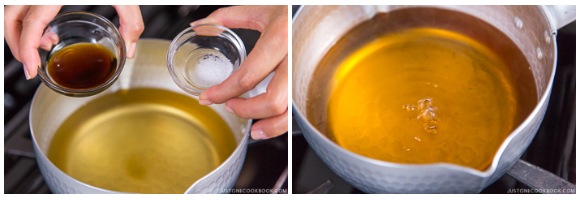

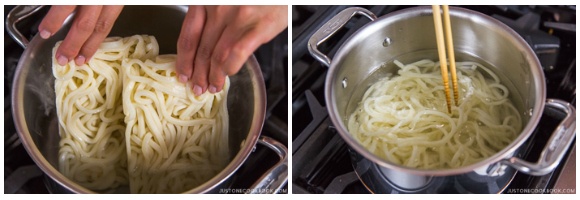
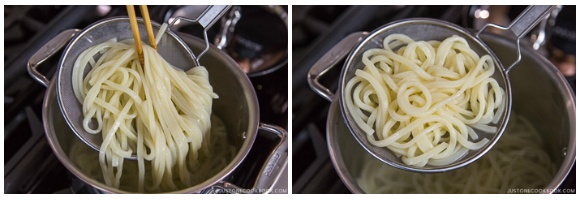
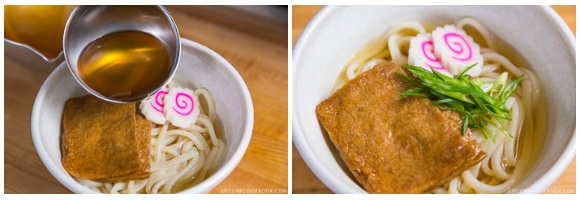

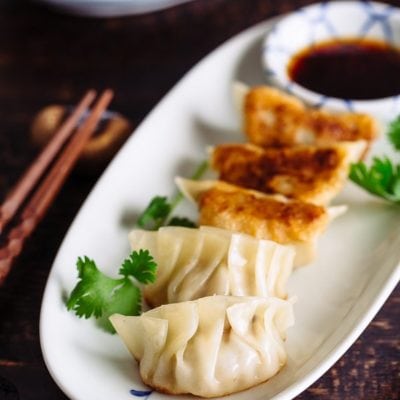
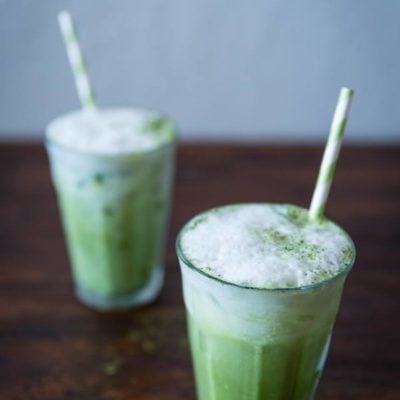

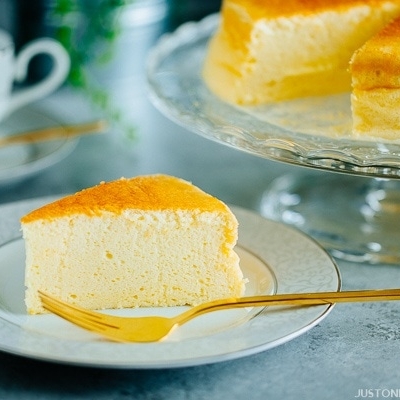

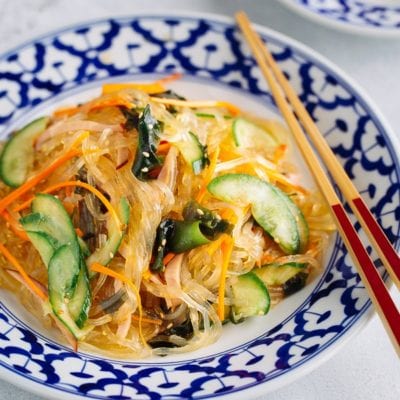

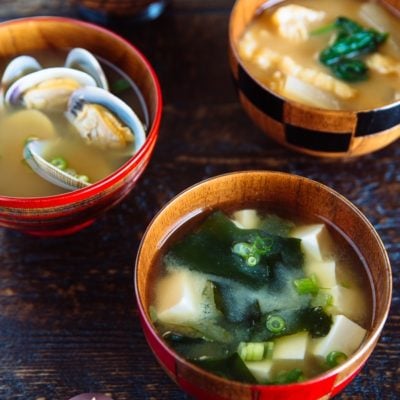


I just made this tonight! So delicious and FILLING too 🙂 Next time I’m making the dashi stock in advance, though- it took me a whole 2 hours to make the stock and the inari age. But it was definitely worth it!
Hi Addie! So glad you liked it! If you make dashi from scratch, yeah it might need some time to make (if you follow the “correct” way, not skipping or cutting down on time). It’s always good to keep dashi in fridge (or freezer). 🙂 Thank you so much for trying this recipe, Addie!
In your recipes, does salt refer to kosher salt or regular table salt? The amounts should vary depending on which one. Also do you use iodized or non-iodized salt, and does it make a difference?
Hi Stephen! I feel so bad. I do remember answering this question from my phone, but now I saw your comment unanswered. I think I failed to post the response somehow.
I always use kosher salt for cooking, and sometimes sea salt if I season after cooking etc. Hope this helps! I’m terribly sorry about this very late response. 🙁
Which soy sauce would be better for this recipe, Koikuchi shoyu or Usukuchi shoyu?
I really want to try it but don’t know which one to use.
Hi Ben! It’s really up to you. People in Osaka area (Kansai area) use light soup for dishes like this, so they use Usukuchi Shoyu. When they go to Tokyo area (Kanto area), they get surprised how dark the soup is. Usukuchi Shoyu is slightly saltier despite the light color. So please adjust. Hope this helps! 🙂
i would try to cook this recipe for sure 🙂 I’m your big fan now will let you know how it’s going to be lol
Hi bb! Aww thank you so much! I’m happy to hear you enjoy reading my blog. 🙂 Hope you like this recipe!
I substituted the narutomaki with beef (my steak’s about to expire) and spinach with mushrooms but it still tasted lovely for dinner. Thanks for the recipe! 😀
Hi KN.W! Yay! I’m very happy to hear you enjoyed this dish (with substitution – it’s really a good thing not to waste food!). Thank you so much for letting me know! xo 🙂
I’m a foreigner living in Japan and was looking for an authentic udon recipe so I can make it at home. This recipe was so delicious! Thank you!
Hi Catherine! I’m so happy you liked this recipe, and thank you very much for your feedback! Hope you are enjoying your stay in Japan! 🙂
I am not a big fan of Udon… But having made this the other day, I have just changed my mind about Udon. The soup is light, comforting and delicious, especially on a cold rainy day!
Hi Alana! I always recommend people to try “Sanuki” udon. It’s more delicious than regular udon. The quality of udon varies. I always buy frozen sanuki udon. Hope you can try that kind (or tried it this time). 🙂
Omg, i love this recipe i make it every fortnight!?!!!!
Thank you! Hope you enjoy it! 🙂
Hi Nami,
I just made the Kitsune Udon for dinner tonight, and I am so amazed at how good it tastes. It is the real thing! When I make this for my friends, I think they will be amazed at the taste. Wow, I just can’t get over how authentic it tastes. There are alot of recipes online, but it’s hard to really recreate a lot of dishes you have eaten at restaurants to taste like it should without having the taste altered in some way. I will definitely be trying more of your recipes!
Thank you for sharing all of your recipes!
Eun
Hi Eun! Thank you so much for your kind feedback! I’m glad to hear you liked the recipe. Ingredients are very simple but the portion is the key, I guess. Japanese seasoning is always soy sauce, sake, mirin, sugar… those are the typical seasoning, but each food has different portion which makes it taste a bit different. I hope you enjoy my other recipes too. Thanks again for stopping by! 🙂
Hi Nami,
I’m going to attempt to make this for my family (who are all recovering from colds) sometime this week. I was just wondering why you prefer using dashi over hondashi, I could only find hondashi at my local japanese store. Also they didn’t have any inariage, just aburaage but I’m told this isn’t a problem.
Thanks for the recipe!
Hi Joseph! Hondashi vs homemade is same theory as bouillon cube vs homemade chicken/vegetable broth. It tastes much better when you make soup from homemade dashi. It takes time to make homemade, so when you are sick or busy, I think it’s convenient and healthier to use hondashi and make this noodle at home than eating out or taking out food. I have nothing against hondashi but if you ask me which tastes better, definitely homemade version. No chemical in it and pure simple flavor.
I am planning to share homemade inari age recipe. Maybe when I can finish editing and writing I can post how to make inari age this week. I use Aburaage and it’s so delicious! I will do my best to finish!
Hope your family will recover from colds soon. 🙂
Thanks for the quick reply! I understand the difference now. I already bought hondashi but next time I will use your how to make Dashi guide. I definitely saw some Kombu at the store so I don’t need to worry about finding that. Would you say there’s a big difference in taste between Awase Dashi and Kombu Dashi?
I look forward to the inari age recipe, I’ll probably have the cold by the end of the week so I’ll need some Udon Soup 😀
I wrote a little bit about the difference between awase dashi and kombu dashi in this post:
https://www.justonecookbook.com/how-to/how-to-make-dashi-jiru/
Awase dashi has smoked bonito flakes (katsuobushi) in it, so it has really good smoky flavor. I like it a lot and use awase dashi for most of my dishes unless I mention. It has stronger flavor than kombu – kombu can be too subtle for some dishes that has strong seasonings.
Hope this helps. 🙂
This dish looks really delicious. I can’t wait to cook this udon dish. I read the legend before and found it wonderful.
Hi Chris! Thank you so much! Hope you enjoy this recipe. 🙂
Oh I love Kitsune udon! It’s my favorite udon ever. I haven’t had any that tastes like the type I had in Okinawa. I might try your way and see if it taste the same. Plus it looks wonderful!
Hi Akane! I hope you like the recipe. 🙂
Hi Nami, I just discovered your blog today and am loving it. All your food looks so yummy. My family loves udon noodle soup. I live in SF too!! Can you tell me which store I can find the dashi packets at? I’ve seen other dashi packets but they all contain MSG. Does Ranch 99 sell them? thanks.
Hi Elaina! Thank you so much for stopping by my blog! I’m so happy you like my little space here. 🙂 I go to Marina (another Chinese market) in San Mateo and they have more variety of Japanese products since the lady who stocks the shelves is Japanese. I used to go to Ranch 99 but their Japanese products are more “American Japanese brand”…so I stopped going there. Therefore, I’m not sure if you can find dashi packet in Ranch 99… Another choice if you live in the city is Nijiya in Japan Town. Hondashi etc has MSG so I try to avoid too. I hope you can find it. You can always make it from scratch (I have the page for How To Make Dashijiru)…but it is more time consuming. 🙁 Hope this helps, and if not, please feel free to write me back!
Oh and PS guess what’s for dinner tonight…!? Yup kitsune udon!!!!!
My mum used to give me her homemade dashi-soup in a bottle (in an isho-bin for sake) every winter so I can just dump the noodles in… Now, I’m making my own 🙂
But still need to turn to her for some “ten-kasu” he he!
Yes! You made Kitsune Udon! 🙂 I’m so happy you made it. I hope you liked the taste of the soup. I used to make just whatever, but after I started to measure, I spent some time adjusting the taste. So far I’m happy with this taste…. It all varies depends on dashi etc, but I hope you liked it! Thank you again for letting me know! I’m so happy! Your mom makes homemade tenkasu? Wow, you really should learn all the cooking from her! 🙂
I just left you a comment before the PS one…but must have been a glitch and didnt post!!!! Anyway i just saying how I love cooking but I never cooked Japanese as I can’t read Japanese and the english ones were just not genuine enough. My mum is known in the community for her cooking so I never tried to make Japanese food…. It all just seemed too hard!!! But after discovering your blog I am loving Japanese cooking and wanted to thank you for your exciting, traditional and very genuine recipes!!!!! I look to you every time and with success!!! I made the pork and eggplant roll yesterday with goma ae and loved it!!!!!!!!!
So thank you again for bringing me back my childhood in my own kitchen!
Kae, I’m sorry. Your comment was in my Spam folder so that’s why it didn’t appear on the comment section. You made Gomaae and eggplant roll too? Waaa I’m so happy! 🙂 I hope you enjoy my recipes, and let me know if you have specific recipe you want to try. I’ll think about it. 😉
I love the details and how you write your blog.. Obviously I’m gonna bookmark this recipe.. Huhuhu actually I’m from Malaysia… I’m totally gonna be a big fans of your blog🌵🌈 btw I’m a muslim and I’ve question to ask, is it okay if I didn’t put the mirin or did you have any recommendations to replace the mirin with another ingredients? ^^
Hi Pija! Thank you so much! I hope you enjoy the recipe. For Mirin and Sake substitute, please take a look at these pages.
https://www.justonecookbook.com/sake/
https://www.justonecookbook.com/mirin/
Hello!
I recently discovered your blog when I googled goma ae recipe.
I am Japanese living in Australia since I was 5. I grew up eating my mum’s Japanese cooking and she is known in the community for being a great cook.
I love cooking but only made western food.
Although I love my mother’s Japanese cooking, I never cooked Japanese myself as I cannot read Japanese and the Japanese cook books available were so obviously nit genuine so I never bothered.
UNTIL I FOUND YOUR BLOG!!!!!!
I absolutely love ur recipes! They are consise, creative and traditional and very very genuine. I end up making a dish I never thought was possible by anyone other than my mum and I have ur recipes to thank.
Your blog is now on top of my bookmarked pages and I wanted to thank you for making my culinary experience more exciting and bringing my past into the present through food.
Thank you!
Hi Kae! Your comment made my day… It’s passed 2am and I am just so happy reading your comment!! 🙂 Thank you so much for leaving a comment here so that I know who is actually reading my blog. 🙂 You are lucky to have a mom who’s a great cook! I started my blog so that my kids who were born here in the US can cook Japanese food one day… I was typing my recipes in Japanese first, then I realized my kids may not be able to read what I was writing! So I started to translate my recipes into English. I’m very happy that people in the world besides my family and friends can use my recipes. Thank you again!